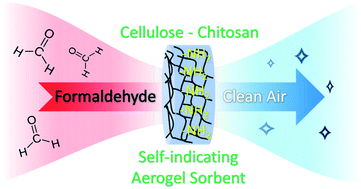Self-indicating and high-capacity mesoporous aerogel-based biosorbent fabricated from cellulose and chitosan via co-dissolution and regeneration for removing formaldehyde from indoor air†
Abstract
The present study demonstrated a novel method to fabricate composite aerogels from the two most abundant, natural, and renewable materials on earth (cellulose and chitosan) as a self-indicating biosorbent to remove formaldehyde from indoor air. The aerogel was prepared via a process of co-dissolution and regeneration of cellulose and chitosan in an inorganic ionic liquid (a concentrated aqueous solution of lithium bromide), in which cellulose contributes to the porous structure and the physical strength of the aerogel, and chitosan provides the reactive sites (amino groups) to chemically bind formaldehyde. The cellulose–chitosan composite aerogel had a highly porous structure and a large surface area (245 m2 g−1), which are favorable properties for a sorbent. The results indicated that a composite aerogel (chitosan to cellulose mass ratio 1 : 2) could quickly and irreversibly adsorb formaldehyde with an observed adsorption capacity of up to 7.5 mmol g−1 (224 mg g−1) when exposed to excessive formaldehyde. The high adsorption capacity of the composite aerogel was primarily attributed to the chemical adsorption via the instantaneous chemical reaction between the amino groups of chitosan and formaldehyde. The physical adsorption of formaldehyde on the aerogel had an insignificant contribution to the overall adsorption capacity. The incorporation of ninhydrin into the composite aerogel provided a real-time color change mechanism to indicate the saturation or expiration of the cellulose–chitosan biosorbent for remediating formaldehyde from indoor air.

- This article is part of the themed collections: Nanomaterials in air and Environmental Science: Nano Recent HOT Articles


 Please wait while we load your content...
Please wait while we load your content...
